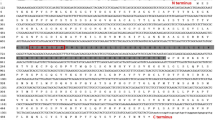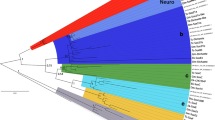Abstract
The Sox (SRY-related high-mobility-group box) family of genes shares a conserved HMG box and is involved in a diverse range of developmental processes and sex determination in vertebrates. Twenty Sox genes are present in the genomes of humans and mice, but far less is known about the Sox gene family in reptiles. Using two pairs of highly degenerate primers designed from a multiple alignment of Sox amino acid sequences in several species, different positive clones were obtained from male and female Eremias multiocellata, a viviparous lizard which is subject to TSD (temperature-dependent sex determination). These clones were sequenced and identified. They are members of the SoxB (Sox2, Sox14), SoxC (Sox11, Sox12) and SoxE (Sox9a, Sox9b, Sox10) groups. No sex-specific differences were observed. Based on the amino acid sequence similarities, the phylogenetic analysis was carried out and these genes clustered with their orthologues. In addition, we found the gene duplication in E. multiocellata, it may be a mechanism to produce new functional genes.
Similar content being viewed by others
References
Sinclair, A., Berta, P., Palmer, M., et al., A Gene from the Human Sex-Determining Region Encodes a Protein with Homology to a Conserved DNA-Binding Motif, Nature, 1990, vol. 346, pp. 240–244.
Schepers, G., Teasdale, R., and Koopman, P., Twenty Pairs of Sox: Extent, Homology, and Nomenclature of the Mouse and Human sox Transcription Factor Gene Families, Dev. Cell, 2002, vol. 3, pp. 167–170.
Bowles, J., Schepers, G., and Koopman, P., Phylogeny of the SOX Family of Developmental Transcription Factors Based on Sequence and Structural Indicators, Dev. Biol., 2000, vol. 227, pp. 239–255.
Nagai, K., Molecular Evolution of Sry and Sox Gene, Gene, 2001, vol. 270, pp. 161–169.
Takamatsu, N., Kanda, H., Tsuchiya, I., et al., A Gene That is Related to SRY and Is Expressed in the Testes Encodes a Leucine Zipper-Containing Protein, Mol. Cell. Biol., 1995, vol. 15, pp. 3759–3766.
Valenzuela, N., Multivariate Expression Analysis of the Gene Network Underlying Sexual Development in Turtle Embryos with Temperature-Dependent and Genotypic Sex Determination, Sexual Dev., 2010, vol. 4, pp. 39–49.
Collignon, J., Sockanathan, S., Hacker, A., et al., A Comparison of the Properties of Sox-3 with Sry and Two Related Genes, Sox-1 and Sox-2, Development, 1996, vol. 122, pp. 509–520.
Cheung, M., Abu-Elmagd, M., Clevers, H., and Scotting, P., Roles of Sox4 in Central Nervous System Development, Mol. Brain Res., 2000, vol. 79, pp. 180–191.
Sandberg, M., Kaellstroem, M., and Muhr, J., Sox21 Promotes the Progression of Vertebrate Neurogenesis, Nat. Neurosci., 2005, vol. 8, pp. 995–1001.
Yuki Oshima, K.N., Yoriko Nakamura, and Masahisa Nakamura, Sox3: A Transcription Factor for Cyp19 Expression in the Frog Rana rugosa, Gene, 2009, vol. 445, pp. 38–48.
Dai, X., Zeng, X., Chen, B., and Wang, Y., The Research on the Karyotypes of Six Species in the Genus Eremias from China, Hereditas, 2004, vol. 26, pp. 669–675.
Zhang, D.J., Tang, X.L., Yue, F., et al., Effect of Gestation Temperature on Sexual and Morphological Phenotypes of Offspring in a Viviparous Lizard, Eremias multiocellata, J. Thermal Biol., 2010, vol. 35, pp. 129–133.
Cremazy, F., Soullier, S., Berta, P., and Jay, P., Further Complexity of the Human SOX Gene Family Revealed by the Combined Use of Highly Degenerate Primers and Nested PCR, FEBS Lett., 1998, vol. 438, pp. 311–314.
Hett, A. and Ludwig, A., SRY-Related (Sox) Genes in the Genome of European Atlantic Sturgeon (Acipenser sturio), Genome, 2005, vol. 48, pp. 181–186.
Li, J., Zheng, P.P., Song, J.L., et al., Isolation and Sequencing of Seven Sox Genes from the Lacertid Lizard Eremias breuchleyi, Genet. Mol. Biol., 2006, vol. 29, pp. 576–579.
Hoser, M., Potzner, M., Koch, J., et al., Sox12 Deletion in the Mouse Reveals Nonreciprocal Redundancy with the Related Sox4 and Sox11 Transcription Factors, Mol. Cell. Biol., 2008, vol. 28, pp. 4675–4687.
Popovic, J. and Stevanovic, M., Remarkable Evolutionary Conservation of SOX14 Orthologues, J. Genet., 2009, vol. 88, pp. 15–24.
Yusuke Kamachi and Kondoh, H., Two Distinct Subgroups of Group B Sox Genes for Transcriptional Activators and Repressors: Their Expression during Embryonic Organogenesis of the Chicken, Mech. Dev., 1999, vol. 84, pp. 103–120.
Lefebvre, V., Dumitriu, B., Penzo-Mendez, A., et al., Control of Cell Fate and Differentiation by Sry-Related High-Mobility-Group Box (Sox) Transcription Factors, Int. J. Biochem. Cell Biol., 2007, vol. 39, pp. 2195–2214.
Schepers, G., Bullejos, M., Hosking, B., and Koopman, P., Cloning and Characterisation of the Sry-Related Transcription Factor Gene Sox8, Nucleic Acids Res., 2000, vol. 28, pp. 1473–1480.
Koopman, P., Sex Determination: A Tale of Two Sox Genes, Trends Genet., 2005, vol. 21, pp. 367–370.
Polanco, J., Wilhelm, D., Davidson, T., et al., Sox10 Gain-of-Function Causes XX Sex Reversal in Mice: Implications for Human 22q-Linked Disorders of Sex Development, Hum. Mol. Genet., 2009, vol. 19, pp. 506–516.
Zhou, R.J., Liu, L., Guo, Y.Q., et al., Similar Gene Structure of Two Sox9a Genes and Their Expression Patterns during Gonadal Differentiation in a Teleost Fish, Rice Field Eel (Monopterus albus), Mol. Reprod. Dev., 2003, vol. 66, pp. 211–217.
Barrionuevo, F. and Scherer, G., SOX E Genes: SOX9 and SOX8 in Mammalian Testis Development, Int. J. Biochem. Cell Biol., 2010, vol. 42, pp. 433–436.
Chiang, E., Pai, C., Wyatt, M., et al., Two sox9 Genes on Duplicated Zebrafish Chromosomes: Expression of Similar Transcription Activators in Distinct Sites, Dev. Biol., 2001, vol. 231, pp. 149–163.
Karsenty, G., Transcriptional Control of Skeletogenesis, Annu. Rev. Genomics Hum. Genet., 2008, vol. 9, pp. 183–196.
Kent, J., Wheatley, S., Andrews, J., et al., A Male-Specific Role for SOX9 in Vertebrate Sex Determination, Development, 1996, vol. 122, pp. 2813–2822.
Maldonado, L., Landa Piedra, A., Moreno Mendoza, N., et al., Expression Profiles of Dax1, Dmrt1, and Sox9 during Temperature Sex Determination in Gonads of the Sea Turtle Lepidochelys olivacea, Gen. Comp. Endocrinol., 2002, vol. 129, pp. 20–26.
Shoemaker, C., Queen, J., and Crews, D., Response of Candidate Sex-Determining Genes to Changes in Temperature Reveals Their Involvement in the Molecular Network Underlying Temperature-Dependent Sex Determination, Mol. Endocrinol., 2007, vol. 21, pp. 2750–2763.
Western, P., Harry, J., Graves, J., and Sinclair, A., Temperature-Dependent Sex Determination: Upregulation of SOX9 Expression after Commitment to Male Development, Dev. Dyn., 1999, vol. 214, pp. 171–177.
Prince, V. and Pickett, F., Splitting Pairs: The Diverging Fates of Duplicated Genes, Nat. Rev. Genet., 2002, vol. 3, pp. 827–837.
Blackburn, D., Reptilian Viviparity: Past Research, Future Directions, and Appropriate Models, in Comparative Biochemistry and Physiology, part A: Molecular and Integrative Physiology, 2000, vol. 127, pp. 391–409.
Thompson, M., Stewart, J., Speake, B., et al., Evolution of Viviparity: What Can Australian Lizards Tell Us? in Comparative Biochemistry and Physiology, part B: Biochemistry and Molecular Biology, 2002, vol. 131, pp. 631–643.
Shine, R., A New Hypothesis for the Evolution of Viviparity in Reptiles, Am. Naturalist, 1995, vol. 145, pp. 809–823.
Author information
Authors and Affiliations
Corresponding author
Additional information
The article is published in the original.
Rights and permissions
About this article
Cite this article
Xin, Y., Tang, X., Yue, F. et al. Isolation and sequence analysis of Sox genes from lizard Eremias multiocellata. Russ J Genet 48, 79–85 (2012). https://doi.org/10.1134/S102279541201019X
Received:
Published:
Issue Date:
DOI: https://doi.org/10.1134/S102279541201019X




